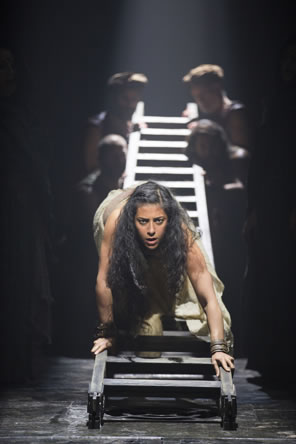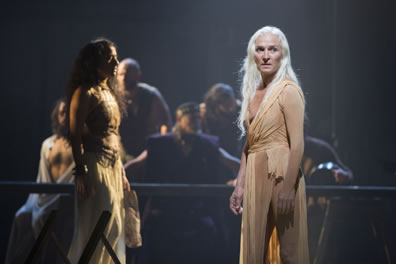Salomé
A Spark of Revolution in a Theatrical Baptism
Adapted and directed by Yaël Farber
Shakespeare Theatre Company, Lansburgh Theatre, Washington, D.C.
Tuesday, October 13, 2015, Q–107&108 (center rear stalls)

Salomé (Nadine Malouf) descends into Iokanaan's cell in the Shakespeare Theatre Company's production of Salomé, adapted by Yaël Farber. Photo by Scott Suchman, Shakespeare Theatre Company.
Never before have I received a letter from a theater preparing us for the play we were about to see. The e-mail, with the subject line of "Before you attend Salomé," came from Michael Kahn, artistic director of the Shakespeare Theatre Company (STC), introducing us to the piece he chose to not only open the company's 2015-2016 season, but also to serve as STC's entry in the Women's Voices Theater Festival. That festival, involving theaters throughout the metropolitan Washington, D.C.–area, features some 50 premieres by women playwrights along with productions directed by women.
Salomé is kind of both. The production is an adaptation of Oscar Wilde's quirky but scandalous one-act piece, written in 1891, published in French in 1893 and debuted in Paris in 1896 (an 1892 London premiere was pre-empted by censors during rehearsals). The adapter and director is Yaël Farber, and Wilde's presence in the new version is scant as Farber draws on ancient Hebrew (biblical) and Babylonian texts for purposes both thematic and contextual. Most significantly, she shifts the perspective to that of the title character and puts the play's political and religious subtexts front and center.
Thus did Kahn write STC subscribers—the kind of theater patrons who clap enthusiastically when the curtain rises on a gorgeously realistic set for Wilde's The Importance of Being Earnest—to warn them that this is not your typical Wilde time in the theater. "You should come to the theater expecting a few things," he writes: In summary, "Don't be surprised or alarmed if you see…juxtapositions of nudity, eroticism, spirituality, and politics in this production." Oh, and a multilingual script, too.
Kahn first encountered Farber when he saw Mies Julie, her adaptation of August Strindberg's Miss Julie set in post-Apartheid South Africa. "I was captivated and excited, and I admired Yaël's ability to transform classical texts to speak to the most pressing issues of our time," Kahn says in his letter. He brought Mies Julie to STC in 2013 and began discussing Salomé with Farber. It is a fitting entry for the Women's Voices Festival, especially as there are not many female authors in the classics canon. Certainly, STC could have mounted yet another production of The Rover or brought to light some other Aphra Behn play (and frankly, among playwrights, William Shakespeare speaks for women as well as many women do, and Kahn could have ridden the tide of all-female productions for any one of Shakespeare's plays). However, reconfiguring such a sex symbol as Salomé—Herod's stepdaughter who does the Dance of the Seven Veils and afterward orders the beheading of John the Baptist—into both a victim of Roman-occupied Judea's misogynist society and a spark of revolution is the kind of woman's perspective the festival was meant to surface.
To be sure, Farber's Salomé is not a grand night of theater entertainment. It is heavy lifting, both intellectually and emotionally. It also is visually stunning, so let's start there. Scenic and Costume Designer Susan Hilferty uses what is seemingly a bare set, including what looks like the black-brick back wall of the theater. A table made of a ladder crosses the back of the stage with chairs lined up behind it, and on both sides are sawhorses serving as tables holding serving bowls and prayer shawls. These pieces of furniture are moved into various configurations to create everything from prisons to altars. A grate lies across the front of the stage, and this serves as the cell where Iokanaan (John the Baptist) is imprisoned. A revolving track circles the center of the stage, which sets in motion at points of transition in the play. Donald Holder's lighting design with its meticulous use of spots, shadows, and highlights is also integral to the play's setting.
But the real scene setter is the person listed second, after Adaptor/Director Farber, on the playbill's artistic team list: Ami Shulman, movement director. The production is as much an interpretive dance as it is a theatrical drama. The production opens with the entire cast entering the stage in slow, measured steps (at the end, too, the entire cast, after bowing as an ensemble, depart the stage in the same manner, visually decreeing there will be no curtain call—what's done is done). How characters move is integral to their depictions, from the gruffly aggressive cop-like Pontius Pilate (T. Ryder Smith), who can't get any answers about what happened "that night," to the Jewish high priests, Caiaphas (Yuval Boim) and Annas (Jeff Hayenga), who move with studied religious pomposity and stand like statues in prayer. The most arresting moment of the production comes when Salomé descends into Iokanaan's cell. As he beckons her, other cast members move the ladder behind her, and her ascent of the ladder eventually becomes, in one seamless motion, a descent accomplished by the cast repositioning the ladder as she repositions herself and Holder repositions the stage lighting. It's a "how did they do that?" moment, yet it serves to heighten the dramatic tension.
Two actresses play the title character. Nadine Malouf is the young Salomé, the one who acts out the events of the night when she becomes fascinated by Iokanaan, is baptized by him, and, upon acquiescing to dance for her father as long as he swore to grant any wish she asked, beheads the prophet. Olwen Fouéré plays the woman in her older years, tracked down after escaping to the desert and living there countless years. She refers to herself as the Nameless Woman—she has a real name, she says, and it's not Salomé, but she never reveals it. This is derived from the Gospels, which don't name her. Fouéré's Nameless Woman serves as narrator and chorus, but also is a character whom Pilate questions and tortures trying to get to the bottom of the incident that sparked rebellion. "Pain whispers to me like an old friend," she says. This Salomé's timeline is convoluted. It starts with the Nameless Woman and jumps back and forth across events, from the murder of Iokanaan over the story of Jesus to the Jewish revolt against Roman rule 30 years later.
The Dance of the Seven Veils is Wilde's creation (at least the name is), and nothing in the script suggests that it is a striptease act, but Wilde may have intended it to be so (the play's banning in England was officially due to its biblical subject matter). It certainly since has become associated with disrobing. However, in this production, the dance is cleverly allegorical, a display of unifying factions rather than shedding pieces of clothing. Salomé's disrobing comes in the baptism scene as Iokanaan (Ramzi Choukair), dressed only in a loincloth, leads her through seven metaphorical gates—each gate requiring the shedding of a piece of clothing—to the final baptism of water. It's a prolonged, ritualistic incantation that, like so many religious ceremonies across cultures, combines the erotic with the esoteric.
There is much contextual history at play in Farber's presentation. Iokanaan was more than a forerunner of Jesus; he was a revolutionary whose baptism ritual was a direct challenge to Jewish temple practices but whose zealotry was aimed at restoring the Hebrew state. Rather than killing him and thereby creating a martyr, Herod imprisoned and tortured him as a means to suppress his nationalist movement. Farber, a native of South Africa, likens this history to that of Nelson Mandela. Iokanaan's death would ignite the rebellion, and that is the motive for this Salomé's actions (Wilde's Salomé, by contrast, is driven by suppressed sexual desire to establish her own sense of power over the male figureheads represented by her stepfather and Iokanaan).

The Nameless Woman (Olwen Fouéré) narrates her story as her younger self, Salomé (Nadine Malouf), passes behind her while Herod (Ismael Kanater) and his company, including Iokanaan (Ramzi Choukair, left) sit at the table in the background in Yaël Farber's Salomé. Photo by Scott Suchman, Shakespeare Theatre Company.
Despite this deeply personal and gender-centric depiction of the Salomé story, Farber's adaptation doesn't take clear sides. The high priests may be pompous and they may be hypocrites, but they make inflammatory demands on the Roman authorities, too, and in history such demands fueled the Jewish uprising. Pilate on the surface is clearly a cruel authoritarian, but he has common sense political judgment, and we can empathize with his frustration trying to understand the peoples of Palestine. Iokanaan may be a man of God and a victim of colonial rule, but he seems dangerous on a psychological, messianic level. The idea that our ideals and our fates often are twains that never mesh is spoken by one of Herod's guards, a Hebrew willing to participate in the torturing of Iokanaan on behalf of his Roman oppressors because "We do not belong to ourselves."
"As you can see, Yaël is a director who challenges audiences," Kahn writes in his letter to subscribers. "She reconnects us with the theater's most ancient traditions: as ritual, as tribunal, as an act of collective testimonial." That he would even see the need for sending such a letter speaks to the crossroads at which the Shakespeare Theatre Company finds itself. It needs to grow new audiences, but its old audience still pays the bills. And so Kahn signs off with this wish: "I hope to see you in our theaters again soon." The line's grammatical construction hints that he had already conceded the box office take on Salomé.
However, giving us this adaptation of Salomé and making it the first production of the subscriber season boldly announces a company that is not ready to roll over completely to the comfortable tastes of its long-established patronage while an ever-more-vibrant D.C. theater scene leaves STC floundering in the dust of tradition. Additionally, STC's Shakespeare productions last season generally eschewed the conceptual esthetes that had become its norm for a more text-centric delivery. I can't predict what the ultimate financial fallout might be for the company, but I know that we ended up renewing our STC subscription in the middle of last season after originally determining not to. After this first outing of the 2015-2016 season, we intend to renew again next year.
Eric Minton
November 2, 2015
Comment: e-mail editorial@shakespeareances.com
Start a discussion in the Bardroom



 Find additional Shakespeareances
Find additional Shakespeareances